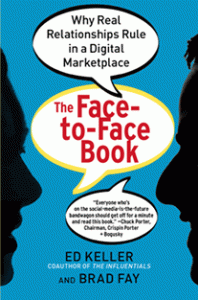 If you sell media, buy media or run a business, you should read the The Face-to-Face Book, by Ed Keller and Brad Fay. Here are some highlights from the book.
If you sell media, buy media or run a business, you should read the The Face-to-Face Book, by Ed Keller and Brad Fay. Here are some highlights from the book.
There are many ways to tap into the power of today’s social consumer. Social media sites are just one way, and still a relatively limited one. PepsiCo provides the most dramatic example of a company that succumbed to the social media gold rush mentality. In 2010, they sharply pulled back on traditional media, especially on television, and most symbolically on their Super Bowl ads. Instead, they placed a very large bet on social media as the smart, new way to engage consumers and drive sales.
- They launched a campaign called the Pepsi Refresh Project, and engaged 87 million consumers through Facebook and other social media in an effort to distribute $20 Million in charitable contributions—all this was an alternative to their traditional advertising
- Their goal was to create community, engage consumers and use all the new social networking tools available to them.
- While the campaign won praise for innovation, it did not sell soft drinks! Pepsi sales were down 6% in 2010, while the industry was down 4.5%, Diet Coke even passed Pepsi as the #2 seller (behind Coke).
- Pepsi announced in early 2011 that they would be raising their traditional ad expenditures by 30% and returned to the Super Bowl.
The authors of this book conduct a weekly survey called TalkTrack… in which they have learned that the average American talks each day about roughly ten brands, and that the typical conversation lasts between 3-5 minutes. More than two-thirds of these conversations involve a recommendation to buy, consider, or avoid the brand.
With so many conversations about brands, there is no doubt the marketplace is truly social. The study also shows that 90% of word-of-mouth conversations are offline (76% face-to-face and 14% phone), and only 8% online (3% Instant/Text Message, 3% Email and 2% Social). And in most cases, the offline conversations are based on ads consumers have seen or heard.
Let's talk. What are you doing to make sure your brand is worth talking about? How are you integrating social, digital and traditional media? What are the pitfalls of a social-only strategy? To learn more about the digital landscape, click here:
John Henley is Chief Operating Officer at The Center for Sales Strategy.



